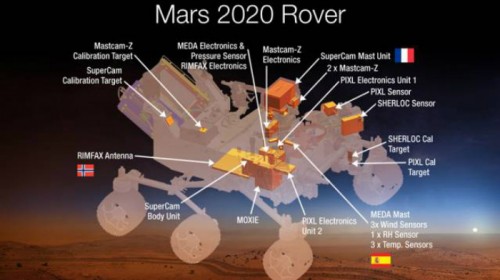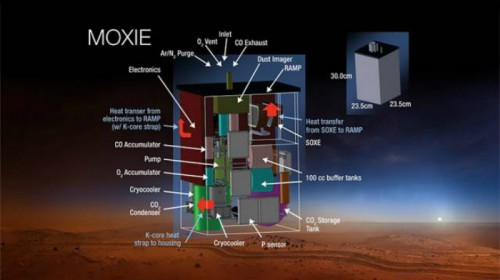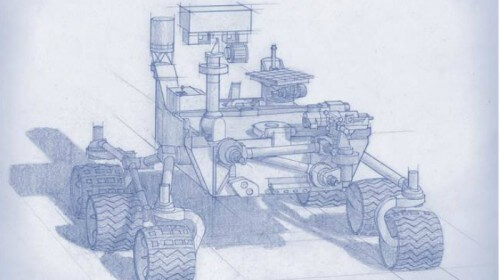NASA's Mars 2020 mission will also operate a facility that will produce oxygen from the carbon dioxide gas in the atmosphere in preparation for a future manned flight. Itai Nebo also reviews the other missions planned for Mars, including the private mission MARS ONE

The US space agency has already landed four spacecraft on the surface of Mars. All of them were engaged in research tasks: searching for water and signs of life, photographing the surface, analyzing the composition of the soil, geological research and examination of the composition of the atmosphere. NASA's next Mars rover, whose launch is planned for 2020, should for the first time not only engage in passive research of the existing, but also conduct an experiment with a unique instrument, which will be the first real step towards flying humans to the Red Planet. The vehicle, known for the time being by its original name Mars 2020 Rover, will carry with it a device for extracting oxygen from the gases present in the thin atmosphere of Mars.
air to breath
The device known as MOXIE (more or less an acronym for: Mars OXygen In situ resource utilization Experiment, i.e. 'an experiment in the utilization of resources to produce oxygen on Mars'), was developed at the Massachusetts Institute of Technology (MIT). The device is actually an inverted fuel cell. A normal fuel cell uses fuel and an oxidizer to produce energy. As mentioned, MOXIE will do the process in the opposite direction: it will invest energy in producing oxygen from fuel materials. In this case the fuel is carbon dioxide, the main component (96%) of the Martian atmosphere. Each molecule of carbon dioxide (CO2), contains two oxygen atoms and the investment of energy in its decomposition should yield oxygen molecules (O2), which we need for breathing.
If the MOXIE experiment is successful, NASA will be able to build a larger system to supply oxygen to crew members who will one day reach Mars. Moreover, MIT says that using the system on a large scale will also make it possible to produce liquid oxygen, which is used as rocket fuel, and will make it possible to launch spacecraft from Mars back to Earth. "I imagine the following scenario," says the head of the research team, Prof. Michael Hecht (Hecht) from MIT, "an unmanned spacecraft drops a large MOXIE system on Mars, next to a nuclear reactor that will provide energy to operate it. In about two years, its oxygen tank is filled, and when astronauts reach Mars, they have both air to breathe and fuel that will allow them to return home." According to Hecht, overcoming the need to bring the oxygen to Mars will reduce 75% of the volume and weight of the manned mission there, and will also relieve NASA of the need to carry out a complex mission, such as dropping a frozen oxygen container separately on Mars.
World chemistry

MOXIE is one of seven devices that the American space agency chose this week for the next Mars rover, out of 58 proposals sent to it by scientists from all over the world. They are mainly intended for exploring the planet's surface with more sophisticated instruments than those available to previous Mars rovers. The other six devices are:
- SuperCam - a sophisticated laser camera designed for chemical analysis of soil composition, developed at Los Alamos laboratories in collaboration with the French Institute of Astrophysics.
- Mastcam-Z - an improved panoramic camera with focusing capability, which allows to investigate with great precision the nature of the minerals on the surface.
- PIXL - a spectrometer (a device for analyzing chemical composition) that works with X-rays, and is supposed to analyze the elements that make up different substances. The device was developed at the University of Arizona.
- SHERLOC – a different type of spectrometer that works with ultraviolet (UV) radiation. The device developed in the NASA laboratories is mainly intended for the detection of organic substances in the soil, which may indicate signs of the existence of life in the present or in the past.
- MEDA - a device for measuring environmental parameters developed at the Technological Institute of Spain, and includes sensors for temperature, humidity, wind speed and direction as well as the amount of dust and the characterization of its particles.
- RIMFAX - a ground penetrating radar developed at the Forskning Institute in Norway, and intended for the study of geological features of Mars below the surface, at extremely high levels of accuracy.
"We are pleased that the Mars 2020 rover will demonstrate our ability to produce pure oxygen from the abundant carbon dioxide," said James Reuther, deputy director of the Mars program at NASA's Space Technology Mission Directorate. "Demonstrating this technology will pave the way for cheap manned missions to Mars where oxygen will be required for life support and rocket propulsion."
Tools developed from the selected proposals will be applied to a space vehicle similar to Curiosity which is currently on Mars, thus saving the development of a new platform, while increasing confidence that the system will operate.
Crowded, but far away
Mars 2020 Rover will be NASA's fifth Mars rover. It was preceded by two Viking landers that landed on Mars in 1976 (and were not mobile after landing) and the Sojourner all-terrain vehicle that landed on Mars as part of the Pathfinder mission in 1997; Spirit and Opportunity that landed in 2004 (both were supposed to be damaged for three months: Spirit operated for more than five years, Opportunity continues to work to this day, and a few days ago broke the record for travel across a celestial gram outside the Earth, completing a journey of more than -40 km); And the research vehicle Curiosity, which these days marks two years since its landing, and it also continues to operate.
In the coming years, the European Space Agency plans to launch two more research vehicles to Mars: Insight, intended for geological research at great depth, scheduled for launch in 2016, and ExoMars, scheduled for launch two years later. It is being developed in cooperation with Russia (which is mainly responsible for the landing system), and its main task will be to search for signs of life on Mars, which of course can also provide guidance for the existence of organic materials, and the elements necessary for sustaining life there today, and for the production of materials necessary for manned missions.

Despite the much expected activity on the surface of Mars, it is doubtful that a human foot will set foot there in less than twenty years. Even though man is getting closer and closer to the technological capabilities needed to accomplish such an achievement, at least in the foreseeable future, no entity will be willing to undertake the financing of such an expensive venture. The Mars 2020 Rover mission will cost nearly two billion dollars. A manned mission would be several orders of magnitude more expensive, certainly if the plan included returning the crew to Earth. The only way to realize the dream of a manned landing on Mars, will probably be a large-scale global cooperation, which may also include the establishment of an intermediate station on the moon, from where it is much easier to launch large spacecraft, due to the weak gravity.
Meanwhile, by the way, a private entrepreneur in the Netherlands decided to start his own program, MarsOne. According to this plan, 24 volunteers will be flown to Mars (in six spacecraft with four astronauts) from 2024, and a manned colony will be established without the ability to return to Earth. More than 200,000 people signed up for the program, and after the first selections, about 700 candidates remained (including eight Israelis). The final candidates are supposed to be chosen in a reality show on Dutch television, but it is very doubtful whether a private body will be able to meet the economic challenge of the task, without the extensive cooperation of countries with money and technology. Landing a man on Mars is still a long way off, but maybe if the MOXIE experiment is successful, the whole enterprise will get a little more air to breathe.

10 תגובות
Now I wonder what is in the drawer regarding the establishment of a station on the moon
A fascinating topic and a fascinating article!
Just fascinating
very serious This is the future. The future is in space vehicles and means that allow existence in place and carrying a volume of fuel that does not increase significantly with distance, and at tremendous speeds not in 100 years, and in a space vehicle that does not turn off the engine on the way because it has enough fuel for the journey and escape.
Tell me, is this serious?! To save the need for landing a Noli oxygen tank, by landing a large machine and a nuclear reactor that powers it!
I hope things are thought about more seriously before implementing them.
Well done, interesting :-) It seems that by the 22nd century there was already a human settlement on Mars.
There are already similar devices, but according to what I understood, it is really not easy to identify tunnels with them:
http://www.calcalist.co.il/local/articles/0,7340,L-3637019,00.html
RIMFAX - ground penetrating radar developed at the Forskning Institute
Which link can't be found on Google
RIMFAX - a ground penetrating radar developed at the Forskning Institute in Norway, and intended for the study of geological features of Mars below the surface, at extremely high levels of accuracy.
Perhaps it can be used to discover tunnels in the Gaza Strip and in the north...